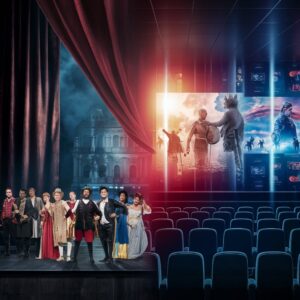In the era of streaming platforms and blockbuster movies, it is tempting to think that traditional live theatre might lose its allure. Yet, theatre has remained a steadfast and beloved art form, captivating audiences in ways that film often cannot. Comparing theatre and film highlights their differences and the unique, irreplaceable qualities that make live performances an enduring experience.
and blockbuster movies, it is tempting to think that traditional live theatre might lose its allure. Yet, theatre has remained a steadfast and beloved art form, captivating audiences in ways that film often cannot. Comparing theatre and film highlights their differences and the unique, irreplaceable qualities that make live performances an enduring experience.
The Immediate Connection
One of the most striking aspects of theatre is the immediacy of its connection to the audience. In a live performance, actors and viewers share the same physical space, creating a communal experience. Theatre thrives on real-time interactions, unlike film, where performances are frozen in time and mediated through a screen. This dynamic energy fosters a sense of participation as audiences react to actors’ performances, and in turn, actors adapt to the mood and responses of the crowd. It is a reciprocal relationship that cannot be replicated by film, where the actor’s performance remains static and unchanging.
The Element of Risk
Theatre’s ephemeral nature introduces an element of risk that is absent in film. Each performance is unique, subject to the spontaneity of live execution. An actor might forget a line, a prop might malfunction, or an unexpected laugh might erupt from the audience. These moments of unpredictability add a layer of authenticity and excitement, reminding audiences that they are witnessing an event that is alive and unrepeatable. In contrast, film productions are meticulously edited to achieve perfection, removing any sense of immediacy or variability.
The Power of Minimalism
Film often creates its world through elaborate visual effects, detailed sets, and expansive locations. On the other hand, theatre embraces minimalism, relying on the performers’ creativity and the audience’s imagination. A single spotlight, a simple set, or a well-delivered monologue can evoke entire worlds. This reliance on the audience’s imagination creates a collaborative storytelling experience, forging a deeper connection between the viewer and the narrative.
Emotional Intensity
Theatre has a unique ability to convey raw, unfiltered emotion. The proximity of actors to the audience allows viewers to witness the nuances of performance—the quiver of a voice, the tears glistening in an actor’s eyes, or the tension in a clenched fist. These subtleties are often lost in film, where close-ups and editing can manipulate how emotions are perceived. In theatre, the audience feels the authenticity of the moment, amplifying the emotional impact.
A Historical Perspective
Theatre has been a cornerstone of human culture for millennia, from ancient Greek amphitheaters to Shakespearean dramas and modern-day productions. This historical weight lends theatre a sense of tradition and timelessness. While film is a relatively recent medium, theatre connects us to a shared human history, linking to the rituals and stories that have shaped societies.
Accessibility and Intimacy
While film can simultaneously reach global audiences, theatre’s strength lies in its intimacy. The smaller scale of many productions fosters a sense of closeness and exclusivity, making every performance feel personal. Whether it’s a grand Broadway show or a local community play, the tangible presence of actors in the same room creates an experience that feels tailor-made for each audience member.
Which medium is superior?
The debate between theatre and film is not about which medium is superior but about understanding and appreciating their unique strengths. Film excels at visual storytelling and mass accessibility, but theatre offers something irreplaceable: a live, shared experience that engages the imagination and emotions in deeply and uniquely resonant ways.
As technology evolves, live theatre remains a testament to the power of human connection and creativity. For those seeking a reminder of what it means to be fully present in a moment, theatre continues to provide an unforgettable experience—one that no camera can ever truly capture.
